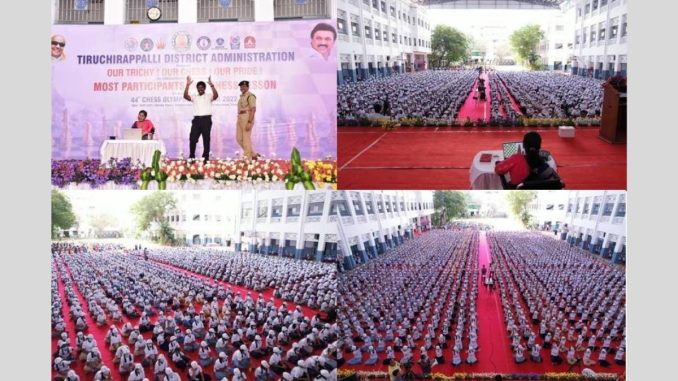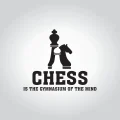
The Dalai Lama once said that there are 34000 distinguishable emotions. Even he would be hard pressed to show a single emotion if he were at the Chess Olympiad in Chennai as a spectator. Because it’s not allowed. They can’t say a hello if a player veers closer to their enclosure, they can’t cheer for their favourite player or flash banners to garner their attention. Mobile phones and cameras have to be kept in the cloak room; they can’t munch popcorn or guzzle the cola, forget the bubbly concoctions; between the audience, they can’t debate or fight, no release of excitement after a piece capture following an elaborate manoeuvre, like after a rally at the Wimbledon Centre Court. Even the players don’t high-five or fist-punch. Nothing moves, everything is static. Watching chess from the galleries seems an exercise in self-control. The silence suffocates.
Perhaps, chess, as Garry Kasparov once said, is never meant to be watched from the galleries as any other spectator sport. “You cannot say, go, go, rah, rah, good move! People want some emotion, but chess is not a sport, but an art,” he had once said. Kasparov never liked crowded halls as he felt the masses distracted him. So an artistic sacrifice or a creative gambit or a surprising gamble are best enjoyed over an online stream or at a chess club with friends. Arguably, it’s this intrinsic, unchangeable nature of chess that makes it spectator-unfriendly when watching from the galleries.
That’s the curse of board games—no board game is a spectator sport. Scrabble fans don’t agonise over the fact that it’s never going to be at the Olympics. They are so close to the action—closer than perhaps a bout of boxing or wrestling, almost within touching distance from the players, yet they are so far from the action to understand what is unfolding on the boards.
Highlights from the beginning of round 5 of the 44th #ChessOlympiad pic.twitter.com/fMQjCkBlHe
— International Chess Federation (@FIDE_chess) August 2, 2022
Not that it has doused spectators from crowding the galleries at the Chess Olympiad. The gallery at the main hall is a few metres away from the boards, where the spectators can stand and watch them from side-on from behind a wall, guarded by volunteers. Hall B gives a better vantage point, as the platform is elevated and there are chairs.
You could watch the players, if the players are expressive, most don’t betray emotions, gauge the mood; if you a chess whiz yourself, you could follow the moves by observing the movement of the hands.
“You get a glimpse of what’s happening on the board closest to the gallery. You can see some of the blocks and then guess the moves and the lines. But for that you need to know the game at a decent level,” says R Raghunathan, a former chess player who has been travelling to the venue every day.
But he says he is here more for the ambience than seeing what’s unfolding on the board. “I am here for the ambience. There are people from everywhere, most top players in the world, Carlsen, So, Caruana, Aronian. I don’t know when I can ever see them again in one tournament. Besides, there are a lot of boys from Tamil Nadu and we need to show them some good home support. If I wanted to enjoy the game and analyse the moves, I could have sat at home and streamed the games online,” he says.
Most of the spectators inside the gallery are supporters and relatives or friends of players rather than aficionados or just there because of the buzz. Like Raghunathan, Felix Anandaraj has been shuttling from Tambaram to Mahabalipuram on his bike in the hot sun just to cheer for D Gukesh, who he knew since childhood. “I don’t know the game much and I don’t understand what’s happening either (from the gallery), but I come here on most days to show my support to meet the players and soak in the whole atmosphere,” he says.
So, most of the chess nuts at the venue gather in the sprawling golf-banks like a courtyard at the venue. There is a giant screen streaming live games from the FIDE live channel with the commentary of Judit Polgar and Mihail Marin. But most have other live streams running on their smartphones too so that they can peek into other games too. But they don’t watch the games without taking their eyes off it. Rather, they enjoy discussing the game within their groups.
Says S Roshan: “What we do is we watch a move and analyse the line, strategies and possibilities among ourselves, doing sort of an alternative commentary. That way, we are playing the game ourselves, working out possibilities and permutations ourselves. Watching chess, like any other game, is best as a community experience. It feels a bit more interesting being here than it does just sitting in front of a chess board at our house.”
It’s how the mind of a true blue chess fan works. While spectators of most other sports enjoy the moment—when a goal is scored or a six is struck—chess fans get their joy from calculating what could possibly happen next, or after that. “We are always thinking of progression, of patterns and possibilities. The best thing about the game is that you can play their game yourselves, and games as far back as those of Capablanca or Alekhine. All you need is a list of moves and a board,” he elaborates.
On that note, chess has more space for the strategic as well as emotional involvement from the spectators. Raghunathan chips in: “We are as emotionally invested in a game or players as spectators in other games too are. We like to see our favourites like in other sports too.” As Kasparov said chess is indeed an art, but like any good art it too stirs emotion in the heart of the connoisseurs.
source








Leave a Reply